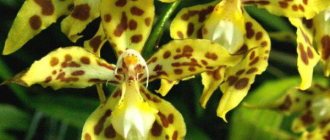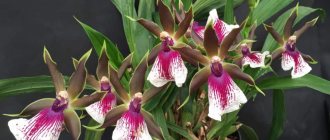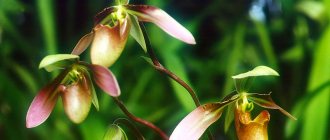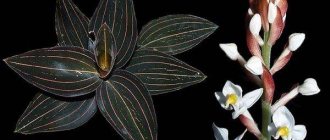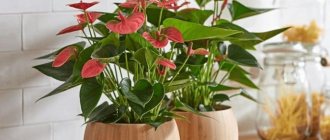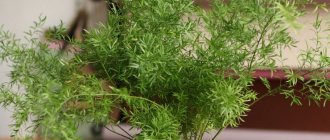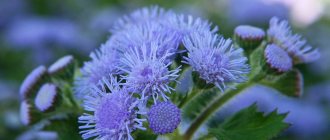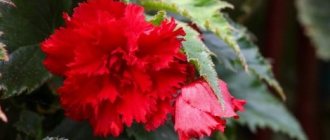Ascocenda is a breeding species of orchid. Biologists have crossed two genera of plants - Ascocentrum and Vanda. From Vanda, Ascocenda acquired dense flowers, and from Ascocentrum, small shrubs.
Author of the article
Maxim Sverchkov
Professional biologist and breeder with extensive experience and experience.
Also, the resulting plant acquired different shades of colors. Ascocenda can bloom 6 times a year. Among indoor plants, it is considered undemanding, so even a beginner can grow it. It is grown in greenhouses, gardens, at home, on the balcony.
Description
The genus Ascocenda is a full member of the Orchid family.
But it owes its appearance not to nature, but to man. These wonderful plants are the successful result of crossing two genera: Vanda and Ascocentrum. From the first, the plant received large flowers, from the second, compact sizes and an expanded color palette of multi-flowered inflorescences. At the same time, the parents were a little “stingy”, not passing on their inherent fastidiousness. The beautiful Ascocenda blooms 3-6 times a year and is considered one of the easiest orchids to care for. Beginners and experienced gardeners willingly add these plants to their flower collections.
Ascocenda has no pseudobulbs. On a strong, erect stem, uniformly colored green leaves are located opposite. The roots are thick and long, sometimes the same length as the entire plant. Peduncles bear up to 25 buds. They open almost simultaneously, turning into large flowers of pink, red, crimson, purple, blue, orange, and brown colors. Often their surfaces are decorated with dashes and spots of other shades.
Flowering lasts up to 1.5 months. Ascocenda is also suitable for cutting. However, a flower placed in a vessel with water lives much less.
Ballerina
In a small region in southwestern Australia you can find an orchid with flowers of an unusual shape.
Ballerina Orchid is a small terrestrial plant that grows in groups or in single bushes.
The color of the flower is cream with dark burgundy individual petals and sepals. The image of a blossoming flower resembles a ballerina in a tutu in a beautiful dance position.
In their homeland, clearings with Ballerinas are mercilessly destroyed by rabbits and kangaroos. The ballerina is currently on the verge of extinction. In its natural environment, the ballerina can live for many years, but blooms for only two weeks.
The stem of the orchid is tall, the curved branch-peduncle turns out to be graceful and lush.
A ballerina at home can do without a rest period and delight her owners with her color all year round.
Growing
Ascocenda reacts negatively to transplants. It is recommended to move to a new container in cases of extreme necessity: during growth or decomposition of the substrate. The key to success is careful handling of roots. Damaged, rotten or dried ones are removed. After transplantation, the plant is kept in dry conditions.
Like the popular Vanda, Ascocenda prefers to exist with its root system released into the wild. Therefore, when placed without soil in a basket or on a block, the orchid grows faster and blooms more often.
Successful propagation of a flower requires not only experience, but also luck. Even experienced flower growers often fail. The fact is that Ascocenda rarely indulges in the appearance of lateral shoots suitable for rooting. That is, the only planting material remains the apical cutting. It can only be cut from a strong plant. The cuttings are dried for several days and then placed in a clean substrate. You will need a stationary or improvised mini-greenhouse (plastic bag). It is necessary to maintain a ratio of increased humidity to 80% and minimal watering until its own roots grow and the plant reaches 15–20 cm in height.
Reproduction of Ascocenda orchid
Ascocenda can be propagated by layering, which forms adult plants. Children can be separated only if it has a sufficient number of roots for independent life. Unfortunately, Ascocenda very rarely forms layerings.
Due to the rapid growth of ascocendas, they can be propagated by cutting off the upper part of the plant that has roots. The stump that remains usually forms babies quickly and easily, but the final rooting of the cutting takes quite a lot of time. There are some recommendations for this propagation method:
- Cuttings are taken only from healthy and strong plants that are not weakened by flowering.
- Cuttings should be cut only with well-disinfected devices.
- The cut area is burned with a lighter flame or over a burner and sprinkled with fungicide.
- The cuttings are dried for several days before planting.
- The substrate needs to be as pure as possible with an admixture of steamed sphagnum moss.
- Water the planted cuttings very little, slightly moistening the substrate. Humidity should be at least 80%.
- Small cuttings can be germinated in live sphagnum, which will ensure sterility, in special indoor greenhouses.
The most reliable reproduction option is the formation of babies on peduncles. But, without treating a flower bud with special chemicals, the formation of a baby from it occurs extremely rarely. To activate the process, remove the scale that wraps it from the kidney and apply a mixture consisting of 50 milligrams of trans-cinnamic acid, 5 milligrams of benzoaminopurine diluted in lanolin.
Ascocenda, with proper and not at all complicated care, can delight with its bright and abundant flowering for a very long period.
First steps after purchase
When transporting Ascocenda, the main thing is to prevent damage to the roots. Overheating or hypothermia does not pose a particular danger to the plant. Keeping this orchid in quarantine is more a tribute to tradition than a necessity. Pests attack it extremely rarely. At first, watering is strictly limited or completely replaced by spraying.
Ascocenda does not like to move from place to place, so it is necessary to determine in advance where the flower will live. You should wait a little while replanting a blooming orchid. Depending on the chosen growing method (with an open or closed root system), after the flowers fall off, it is necessary to place Ascocenda in a pot with substrate, in a basket or on a block.
Structural features
These are orchids with one growing point, the so-called monopodial type. One single stem grows throughout life. The shape of the leaf blades is inherited from vandas: they are belt-shaped, slightly folded along the central vein, and at the tip there is a bifurcation into two unequal lobes. The roots of the plant are covered with a thick layer of velamen (dead tissue), which retards the evaporation of moisture.
Secrets of success
Ascocenda likes abundant lighting and long daylight hours. Brief exposure of the flower to direct sunlight is not dangerous, however, in the summer months it is advisable to provide shading. The “origin” of light – natural or artificial – is not of fundamental importance. The need for lighting in winter or when placed on northern windows is fully satisfied by fluorescent lamps.
Ascocenda is a heat-loving orchid. Optimum daytime summer temperatures are +23–27°C, 16–22°C in winter. There is no need for special measures to organize night cold snaps. The plant is quite content with natural changes.
The life cycle of a flower does not include a period of rest. However, when the air temperature drops below +15°C, it can be “modeled”. Reduce watering, cancel fertilizing. A short rest stimulates flowering.
Without watering and moistening, Askocenda cannot exist. The water supply of a flower must be subject to the principle of reasonable sufficiency. A flooded root system and undried leaves and stems provoke the appearance of the most dangerous enemies of the orchid - all kinds of rot.
Ascocenda is fed every third watering with fertilizer for orchids. At low light levels and cold weather, fertilizing is canceled. In addition, you should not fertilize a newly transplanted, weakened plant or a specimen with damaged roots. The best results are obtained by using low concentration solutions.
Diseases
The orchid has high immunity, but if not cared for properly it can get sick.
- If the roots begin to rot, it may be due to mechanical damage, poor ventilation, or water retention in the roots.
- If leaves begin to fall off, it may be due to intense sunlight, poor watering, or an aging plant.
- If an orchid does not bloom for a long time, this may be due to insufficient lighting, improper fertilizer, or poor watering.
If such problems appear, correct agricultural practices.
Lighting.
Wanda is very picky about lighting conditions. The light should be bright with the obligatory presence of direct sun, but in the midday hours light shading with paper or a tulle curtain, etc. is necessary. In the autumn-winter period, when the light falls, the best place for it is the window sill of a south window, although even on it Additional lighting may be required. With insufficient lighting, vanda grows but does not bloom. In spring and summer, it is better to place it on an eastern or western windowsill.
External characteristics
The modified apical leaves of the Kaoda Twinkle orchid hybrid, forming a corolla, are very dense dark cherry with a strong waxy coating. When sunlight hits a flowering plant, the petals shine and shimmer. The height of the heterotic hybrid is average, the stem hidden by leaf blades reaches 25 cm -75 cm.
The color of the leaves, which grow up to 35 cm in length and 15 cm in width, is rich green. Depending on the plant variety, the length of the leaves of phalaenopsis Kaoda twinkle may vary. Main characteristics of the hybrid:
- height of the stem with peduncle 35 cm-75 cm;
- the number of leaf blades of an adult phalaenopsis is six to seven;
- maximum peduncle height – 55 cm-65 cm;
- a flower of regular shape with symmetrical modified apical leaves reaches a diameter of 6.5 cm-8.5 cm.
Watering
For watering, it is recommended to use the immersion method. The container is filled with liquid, and then the flower itself or the container with it is carefully lowered into it for half an hour. During this time, the root system should have time to become saturated with moisture. It should be remembered that the velamen covering the roots should acquire a green tint instead of grayish-silver (in a dry state) and swell.
How often a given orchid needs to be watered has a direct relationship with the growing method. When growing in a pot in a substrate, you should pay attention to the bark. After it becomes monochromatic and looks dry, it will be necessary to water it. In the basket, you can check how moist the bark is with your hands. In both the first and second cases, it is necessary to water only after the substrate becomes completely dry.
The most frequent watering is required for plants grown with free roots. In this case, you need to pay attention to the condition of the root system. After the surface of the velamen wrinkles a little, it is necessary to water it. However, this growing method often requires daily watering.
For moistening with a sprayer, as well as for watering, you need to take well-settled, soft water, which should be at room temperature. In the case where water from the water supply is additionally processed, it is recommended to filter it before entering the pipes.
Temperature.
Wanda develops very well in the normal thermal conditions of our apartments. Unlike many other orchids, it does not require a difference between night and day temperatures. Summer heat has a very bad effect on development, so it is better not to keep it at temperatures above 28⁰C. High temperatures can lead to inhibition of growth and cessation of flowering (or failure to do so).
Photo:
Ascocenda Princess Mikasa 'Blue Velvet' (Ascocenda Royal Sapphire x Vanda coerulea)
GENERAL INFORMATION:
Ascocenda Princess Mikasa
is a hybrid whose parents are Ascocenda Royal Sapphire and Vanda coerulea [read more about the pedigree of the orchid...]. The orchid was officially registered in 1983 and is currently one of the most common among white, pink, and blue plants.
The orchid is monopodial, i.e. consisting of a stem densely covered with V-shaped leaves. The leaves are quite soft, straight, light green, forked at the tips, measuring about 20 cm long and 2.6 cm wide. Peduncles appear from the axils between the leaf and the stem, reach a length of up to 35 cm and bear no more than 7 flowers. Flowers range in color from white to dark blue, odorless, about 8 cm in diameter. The upper sepal and petals are round in shape, measuring 4 cm long and 3.5-4 cm wide. The lateral sepals are somewhat larger, measuring 4.5-5 cm long and 4.5-5 cm wide. The lip is triple, its upper parts are strongly raised upward, and the anterior one is in the shape of a tongue, measuring 2 cm long and 0.6-1 cm wide.
Depending on the color option there are:
- Ascocenda Princess Mikasa 'Blue Velvet'
- deep blue flowers. - Ascocenda Princess Mikasa 'Pink Charm'
- pink flowers. - Ascocenda Princess Mikasa 'White Angel'
- white flowers with a hint of pale green.
TEMPERATURE:
When considering the temperature regime of an orchid, it is necessary to clearly distinguish between the concepts of USEFUL and TOLERABLE temperatures, since not every heat tolerated by an orchid benefits it; the orchid simply sits motionless and “endures.”
The range of TOLERABLE temperatures ranges from + 3 °C to + 47 (sometimes + 52) °C; one can even say that among the entire variety of orchids in this group, Ascocenda Princess Mikasa is the most tolerant of both low and high temperatures. However, here you need to understand some nuances: well-watered, it will withstand heat better, and vice versa, dry - cold.
USEFUL temperatures are temperatures at which as many new cells (roots, peduncles, leaves, etc.) of a plant are formed. It is believed that an orchid such as Vanda (or Ascocenda) belongs to a warm temperature regime. This, of course, is true, but it applies to the natural climate of orchids, where they almost always exist in conditions of high air humidity, i.e. their PHOTOSYNTHESIS follows the C3 / C4 principle. Stomata, located (mainly) on the inside of leaves, open in the daytime, fix carbon dioxide and immediately release it for processing. Of course, at some temperatures this process goes faster, at others a little slower, but it does not play a dominant role here; the orchid can equally be grown here in warm and moderate conditions. In simple terms, if you are going to keep Ascocenda Princess Mikasa in a greenhouse, with an air humidity of 70% or higher, then a warm temperature regime is ideal, or hot in summer and cool in winter.
A completely different picture is observed on our window sills, where there is practically no high air humidity; moreover, it is harmful to our apartments and can lead to the formation of mold on the walls. Here the orchid functions in a different mode called CAM PHOTOSYNTHESIS. Stomata open at night, fix carbon dioxide, but process it during the day. The formation of new cells in orchids is slower than in greenhouses. This is where TEMPERATURES begin to play a more significant role. So, for example, in order for an orchid to be able to record at least a minimum of carbon dioxide at NIGHT
,
ambient
TEMPERATURE not be higher than + 24 °C
, ideally 16-18 °C. The difference is in the quantity, whether it will be 1 (conventional) unit, or 10 or 20 (conventional) units. In addition, the amount of gas "consumed" is affected by daylight, the brighter it is, the more CO2 can potentially be collected at night. We all know that the brighter the sun shines, the higher the thermometer rises, i.e. with CAM PHOTOSYNTHESIS, it is necessary that it be sunny and warm during the day and cool at night, this is how the orchid will work well, growing new leaves and flower stalks.
Watching your orchid in the summer, you may notice that even in the absence of a clear nighttime decrease, it is still growing. Don't jump to conclusions that everything is great. If the orchid cannot receive carbon dioxide from the outside, then it will take it inside, redistributing it from older leaves or roots, gradually depleting them, and the longer this continues, the faster they will die - they will turn yellow and dry out.
Photo: Ascocenda Princess Mikasa 'White Angel' (Ascocenda Royal Sapphire x Vanda coerulea)
Photo:
Burns on orchid leaves
LIGHT:
Considering the need for sunlight, we can say that for Ascocenda Princess Mikasa it is slightly lower than in general for the Vanda group. This hybrid is considered one of the most adapted for home keeping and even in EASTERN windows it blooms at least once a year.
Sunlight should be bright, but (if possible) not direct, since starting from 25,000 Lux, there is a possibility of burning - the leaves turn white and cease to perform their direct functions.
IN THE WESTS
and
SOUTH
windows, the orchid grows well and blooms regularly, however, this is where the likelihood of burning is highest. Let's try to figure out why this happens.
In the life of almost any natural plant, both Ascocentrum(s) and Vanda(s), from which the Ascocenda hybrid ultimately appears, sunlight shines approximately the same throughout the year. Plants do not have clear divisions into spring, summer or autumn; they are always in motion - growing new roots and leaves. What happens when they land on our windowsill? In spring and summer there is a lot of sun - they grow actively, and in autumn and winter, like all our flora, they “fall asleep”, i.e. the metabolism inside the plant becomes so slow that the orchid simply cannot grow. This condition is very unpleasant for the plant, it is in shock (stress), and the longer it sits like this, the more the structure of the sap changes, the antibodies that previously prevented the penetration of harmful fungi and bacteria cease to be produced, toxic substances are formed - the plant gets sick. An orchid may, for no apparent reason, begin to shed apparently completely healthy leaves and die within 2-3 weeks. In this case, it doesn’t even matter what exactly caused such a deplorable condition, it is important that the MAIN REASON IS LACK OF LIGHT
.
Photo:
Active root growth
Each plant has its own light limit, above which it grows, below which it “sleeps”. For some it is 800 Lux, for others - 200 Lux, for others - 1,000 Lux. There is one simple way to check whether your plant currently has enough sun or not, you need to look at its roots. If the tips of the roots are in active growth, there is sufficient light, but if they are covered with white skin, the orchid is “sleeping.” The LIGHT BORDER of Ascocenda Princess Mikasa is low and similar to the level of many Phalaenopsis(s). Your task is to choose the location of the orchid SO that all 12 months of the year you observe the growing tips; this will be the most optimal for the plant.
Let’s assume such a situation that in winter only 200 Lux shone on our orchid, the tissues of its leaves changed somewhat, darkened, and suddenly in mid-March the sun sharply jumped to 6,000-10,000 Lux, shone on our orchid for only a couple of hours, and it turned white, received a severe sunburn. The leaves were not prepared for such a strong sun, and their burning occurred in contrast. Therefore, if your orchid does not show signs of life for a long time in the bright direct sun, it needs to be accustomed gradually.
Leaf burns can also occur on trained plants if, in the hot summer, they are exposed to DRY (i.e. not watered) very strong sun, so in the summer on SOUTH and WEST windows, try to hide orchids behind tulle curtains or stir them in this way at the top of the window so that they are not exposed to direct sun. If you grow orchids in glass vases [more...], then keep them in the heat with their roots in water, this will soften the blow.
Photo:
Roots of a dormant plant
On the EASTERN
and
NORTH
windows, you may need, in addition to natural lighting, to install artificial light lamps -
FITOLAM
[read more about lighting orchids...]. Here you need to more carefully monitor the condition of the roots, since if there is not enough light, this will begin much earlier than on the western or southern side. There cannot be universal advice here, since the eastern window in Moscow and the eastern window in Sochi are two big differences.
SUBSTRATE:
When choosing a method for growing this hybrid, you need to take into account that Ascocenda Princess Mikasa is an epiphyte with a fairly thick layer of velamen and a large number of chloroplasts in the bark, through which photosynthesis occurs. They are long, stretch in different directions, often branching, thereby creating a large area for capturing light and accumulating water.
The lowest small and thin roots are not just roots that appeared on the plant during its childhood, when it was not even able to bloom, but also roots that performed (among other things) a fastening function. Just as in nature the Ascocentrum or Vanda is attached to a tree trunk, so here the orchid is attached to a block or basket. Their velamen is the thinnest, 1-2 cells, and there are practically no chloroplasts.
Further along the stem, thicker and longer roots will always grow; this property is inherent in them at the genetic level, since each Vanda in nature settles on the trunks and branches of trees, where there are large cracks in the bark, this is where large accumulations of nutritious humus are located. As soon as it begins to excise, the orchid massively grows new roots and, like tentacles, sends them in different directions in search of new nutritional cracks. Their velamen layer can reach 12-14 cells, and the number of chloroplasts is simply huge, so pushing such roots into pots or baskets is truly a crime, thereby depriving them not only of air, but also of light. The root must initially be adapted to a constantly moist environment, and if from birth it was designed to capture light, then it will no longer be able to live comfortably in the substrate.
THE IDEAL WAY
growing -
WITH A BARE ROOT SYSTEM
in a small plastic basket or on a block. Orchids are hung at the top of the window and watered and fertilized as often as possible. This option is closest to nature, and in itself is the greatest guarantee that the orchid will not get sick for as long as possible.
Planting in substrates
is possible, but you need to approach it wisely. It should be a warm and sunny windowsill, where there are no strong cold snaps, and the orchid is exposed to bright, good sun all the time. Constantly wet roots will not solve the problem of low air humidity on the windowsill, since it is primarily important not for the work of the roots, but for the work of the leaves. Yes, this can soften the fate of the orchid during the hot summer, when water evaporates en masse from the surface of the leaves, while the sun is shining, the roots work, absorb moisture and fill the gap, but in winter everything is somewhat different - moisture evaporates en masse from the surface of the leaves due to hot air from the battery, the sun hardly shines, and this greatly complicates the work of the roots, they cannot drink, losses are almost not replenished, but pathogenic fungi multiply massively, potentially dangerous to the health of the plant (rotting of roots and stems).
Recently, keeping plants in GLASS VASES
or
GLASSES
, read more about it
here...
AIR HUMIDITY:
Despite the fact that Ascocenda Princess Mikasa is a hybrid whose representatives do not live in the wild, the orchid still inherits from its natural relatives not only the structure of the external part (stem, leaves), but also the flow patterns of internal processes.
In the native climate of most representatives of natural Ascocentrum and Vanda, of which this hybrid is composed, short-term rains occur almost every day, thereby keeping the humidity level at 85-87%. It cannot be said that air humidity plays a key role in the development of an orchid; this is not entirely true; its influence is indirect: some processes are accelerated, others are slowed down. However, it is impossible to say that low humidity is fatal.
Air humidity regulates the gas exchange of the plant. In conditions of low air humidity, an orchid can fix carbon dioxide (an important component of most chemical processes inside a plant) only in the dark, and process it during the day; the rate of development slows down. But when the air humidity is above 70%, carbon dioxide is fixed during the day and immediately enters into processing - the growth of new cells accelerates.
An equally important function of air humidity is maintaining water balance. The plant is designed in such a way that during its “life activity” it not only absorbs the moisture necessary for growth and development, but also evaporates it from the surface of the leaves and stem. The dominant influence on this process is provided by sunlight, under the influence of which the orchid heats up and the rate of “sweating” increases. At temperatures from 18 to 28 °C and regular watering, this process proceeds in a completely normal, natural way - as much water has evaporated, the same amount has been absorbed by the roots, etc. At higher temperatures, the rate of water absorption slows down, and when the thermometer reaches + 38 °C, it almost stops completely. However, with all this, the active evaporation of moisture from the surface of the leaves not only continues, but picks up speed, gradually leading to their withering, since the work of the roots is stopped and the wasted water is not replenished. When air humidity is 55% or higher, the process of “sweating” in Ascocenda Princess Mikasa is significantly slowed down, maintaining the moisture balance at the proper level. It has been noted that under conditions of regular watering at 16-28 °C, the orchid can be kept at normal room humidity without harming its health.
To increase the air humidity directly around the plants (not to be confused with the room as a whole), you can use a humidifier or equip the window sill with trays with wet expanded clay (sand, peat, etc. materials). Under the influence of a heating factor - (direct) sunlight or a battery (in winter), the expanded clay heats up, the water evaporates, increasing the air humidity around the orchids. If there is no heating, it is recommended to place a heater at the bottom of the pan.
REMEMBER
that when caring for orchids in conditions of high air humidity, it is necessary to regularly ventilate the room where the plants are kept, since moist, stale air is an ideal environment for the mass reproduction of various types of fungal and bacterial diseases.
WATERING:
The frequency and abundance of watering orchids of this type directly depends on the intensity of lighting and the general temperature of the room; the higher they are, the more often and more abundantly they need to be watered. The bright sun provokes the growth of new cells, so the need for water increases, and vice versa, a decrease in light intensity slows down metabolism, and the absorption of water by orchid roots is significantly reduced, and in very poor lighting conditions, for example in winter, it can stop completely. In this case, it does not matter whether you water your plant or not, water flows by capillary action into the upper layer of the root - velamen, but does not pass further into the plant. When growing orchids with a bare root system, problems with this, as a rule, do not arise, since the water evaporates easily, but in pots, due to reduced ventilation, this is much more difficult. The water sits for a day, two, three, of course, something evaporates, but the remainder begins to destroy the cell walls, causing rot.
Photo:
Ascocenda Princess Mikasa 'Blue Velvet' (Ascocenda Royal Sapphire x Vanda coerulea)
It is advisable to water plants growing on blocks or simply without anything daily in the first half of the day so that by evening their roots can dry out relatively well. If you do not have the opportunity to do this so often, then at least try to adhere to the following recommendations:
- at temperatures from + 16 to + 18 °C (for example, in winter), watering once a week will be sufficient;
- at temperatures from + 20 to + 22 °C it will be enough to water at least once every 3-4 days;
- at temperatures up to + 24 °C it can be dried for 2-3 days;
- at temperatures above + 26 °C, try to do this every day, even if only a little.
REMEMBER
that a plant in active growth constantly requires moisture to form new cells (roots, peduncles, etc.), and if it is not provided in sufficient quantities, it will begin to take it from older leaves, gradually drying them out .
The method of watering an orchid with a bare root system can be:
- in the shower, by spraying both the roots and the entire plant, or
- by soaking for 15-20 minutes in a container of water.
Photo:
Ascocenda Princess Mikasa 'Blue Velvet' (Ascocenda Royal Sapphire x Vanda coerulea)
In no case should you soak orchids in the bath with your head for more than 40 minutes; the leaves of Ascocenda Princess Mikasa are very delicate and can deteriorate. Your orchid will lose all attractiveness and will remain so for many years. Only the roots should be in contact with water, and if you really want to wash the entire plant, then later hang it up and spray it from the shower. Many orchid lovers spray the plants in the morning (before work or school) from the shower during the week, and on the weekends they give it plenty of time to swim in the bathtub.
In spring and summer, the intensity of sunlight increases, and the overall temperature of the content increases, and this is where new difficulties await us. Avoid watering very overheated plants, as a sharp temperature change can cause damage to both the leaves and roots of the orchid (for example, the appearance of small black spots on the leaves or drying out of the root system). The orchid needs to be removed from the scorching sun (for example, in the bathroom), allowed to adapt to the lower temperature and cool for 30-40 minutes, and then watered.
Photo:
Leaf damage from water
When watering orchids in pots, you must remember that excess water should flow freely from the pot when watering, since stagnation of water both inside the pot and in its tray can very quickly lead to rotting of the roots and lower part of the plant (rhizome).
An important factor in caring for Ascocenda Princess Mikasa is QUALITY
irrigation
WATER
, for example, it is considered ideal for a plant: water conductivity 100 to 200 µS (maximum 600 µS), acidity 5-6 pH, and hardness not higher than 12 °dH. In view of this, it is PREFERABLE to use soft, filtered water for irrigation (for example, through reverse osmosis) or a mixture of ordinary tap and distilled water in a 1:1 ratio. When using tap water, remember that its quality is better in a hot tap, since it contains fewer impurities to prevent scale on the pipes, and accordingly, its pH is not very high [read more about watering orchids...]. The worse the water used, the more harmful compounds will accumulate in the substrate and the higher the likelihood of mass burning of the roots!
Between waterings, the orchid must drink all the moisture available in the substrate, i.e. it must be completely dry. At the same time, you should not focus on a certain number of days - this is fundamentally wrong, since the rate of drying (drinking) of the substrate is influenced by too many factors, such as illumination, the general temperature of the plant, air humidity, etc. Today the orchid will dry out in 7 days, and next time in just 2 days, and then cloudy days will begin, and the substrate will dry out for at least 20 days. In addition, this happens extremely unevenly. For example, on the surface some of the water evaporates, and the bark becomes dry much earlier than the insides. Over time, you will learn to instantly determine whether it is time to water the orchid or not, but until this happens, try picking with your finger or a wooden stick, checking the degree of moisture in the inner layers.
If you keep your plants in glass vases, then after watering it is a good idea to check whether all the water has been removed from the bottom, since its stagnation can cause rotting of the root system or active growth of algae.
Photo:
Leaf damage from water
FEEDING:
Photo: Root burn
During the period of active growth (focusing on the tips of the roots), this hybrid is fertilized once every 2-3 weeks at 1/4 or 1/6 of the fertilizer concentration indicated on the package. The roots of Ascocenda Princess Mikasa are quite sensitive to various types of potassium, phosphorus, etc. salts contained in the fertilizer and can deteriorate very quickly. The most sensitive part of a growing root is its tip, and when exposed to too concentrated fertilizer, they turn black and dry out. In addition to regular root feeding, foliar feeding can also be done, when the outer part of the plant is sprayed with a very diluted fertilizer. It is best to feed the orchid by alternating both of these methods. It is advisable to use a specialized fertilizer, marked on the package “For orchids”, since conventional fertilizers for indoor plants are oriented for use in ordinary soil and when used in bark-based substrates, most of the salts settle as dead weight in the substrate itself, creating an unfavorable environment for the root plant. orchid systems environment, leading over time to their massive burning. The best fertilizer is considered to be one containing nitrogen, phosphorus and potassium in equal parts, for example, NPK = 3-3-3 or 8-8-8. If you do not have such a fertilizer, then alternate - once a fertilizer with a high nitrogen content, and another time with a high phosphorus content.
REST PERIOD:
The natural climate in the homeland of some Ascocentrum and Vanda species implies a short dry winter period, but for most, precipitation falls evenly throughout the year (sometimes more than usual, but not less), as such there is no significant decrease in light intensity, therefore orchids do not stop in their development and grow green mass, roots and bloom all year round. However, when growing Ascocenda Princess Mikasa in our latitudes on an ordinary windowsill (without the use of additional winter lighting), situations are not uncommon when natural light becomes so scarce that the metabolism inside the plant is inhibited, and it “falls asleep” until spring. In this situation, several nuances need to be taken into account:
- A “sleeping” plant almost does not absorb moisture; when watering, water flows capillarily into the upper layer of the root - velamen, but does not go further, therefore, if your orchid has fallen asleep due to insufficient lighting, then watering it is to keep the roots in good shape so that they do not dry out ahead of time, and accordingly, there is no need to abuse it.
- If your “sleeping” orchid is located near a heat source - a radiator, then moisture is actively evaporated from the surface of its leaves, which in turn is not replenished through the roots. In such conditions, after some time, the leaves of the plant will weaken, wrinkle and droop. REMEMBER
that the lower the temperature, the less the plant “sweats”.
As soon as the light intensity increases in the spring, the orchid will wake up and continue its development further.
IN SUFFICIENT LIGHTING
Ascocenda Princess Mikasa grows green mass, new roots and blooms all year round. The orchid perfectly adapts to 100% artificial lighting and is able to bloom regularly already under two 54 Watt fluorescent lamps for aquarium plants with a reflector, located at a distance of 30-40 cm above the plant.
Photo: Ascocenda Princess Mikasa 'Blue Velvet' (Ascocenda Royal Sapphire x Vanda coerulea)
BLOOM:
Ascocenda Princess Mikasa can bloom at any time of the year, especially preferring spring and summer in home culture (good bright sun outside the window). Under optimal light conditions it can bloom 2-3 times a year.
AFTER FLOWERING:
After flowering, the peduncle of Ascocenda Princess Mikasa is removed. Although they have peduncles visually similar to Phalaenopsis, they, nevertheless, do not branch and do not produce lateral shoots, just as the peduncles do not elongate.
REPRODUCTION:
At home, this hybrid reproduces quite rarely, by forming lateral shoots on the stem of the plant. In greenhouse conditions, seed propagation, meristem propagation and the cutting method are also used, when a large, well-developed plant is divided into two or more parts.
OUTDOOR RESIDENCE:
In the period from mid-May to mid-September, it is possible to find Ascocenda Princess Mikasa outdoors: on the balcony or in the garden, since it is here that the night temperatures drop naturally, which in turn is one of the factors that stimulates the flowering of the orchid. A place should be chosen that is protected from rain, strong winds and direct sunlight. Long-term practice shows that such plants grow more developed and bloom much more abundantly.
Photo: Ascocenda Princess Mikasa 'Pink Charm' (Ascocenda Royal Sapphire x Vanda coerulea)
KNOWN HYBRIDS:
Based on Ascocenda Princess Mikasa, the following strategically important HYBRIDS were formed:
- Ascocenda Christine
= Ascocenda Princess Mikasa x Vanda Judy Fister - Ascocenda Claude Vorbe
= Vanda Josephine van Brero x Ascocenda Princess Mikasa - Ascocenda David Peterson
= Ascocenda Princess Mikasa x Vanda Gordon Dillon - Ascocenda Judith Brand
= Ascocenda Princess Mikasa x Vanda Fuchs Fortune - Ascocenda Orchidom Sapphire
= Ascocenda Karen Ono x Ascocenda Princess Mikasa - Ascocenda Oriental Mikasa
= Ascocenda Princess Mikasa x Ascocenda Peggy Foo - Ascocenda Redland Cherry Tart
= Ascocenda Princess Mikasa x Vanda Kasem's Delight - Ascocenda Ruth Campbell
= Vanda Mevr. L. Velthuis x Ascocenda Princess Mikasa - Ascocenda Yoko
= Ascocenda Princess Mikasa x Vanda lilacina - Christieara Florencia and Orlinda's Honor
= Ascocenda Princess Mikasa x Aerides odorata - Vascostylis Merinda Sweetness
= Ascocenda Princess Mikasa x Rhynchostylis coelestis
All of the materials presented above are the property of this site, the full or partial publication of which (according to Article 1270 of the Civil Code of the Russian Federation) on other resources without the consent of the copyright holder is prohibited and is punishable by a fine of 10,000 to 5,000,000 rubles (Article 1252 of the Civil Code of the Russian Federation).
World of Orchids
Main cultivation problems
Root rotting
The following can lead to root rot:
- Excessive watering;
- Waterlogging of the soil;
- Heat;
- And lack of lighting.
Remove the plants from the pot and lightly dry the roots. Use a sharp knife to trim off any rotten or dried areas. Treat the roots with a fungicide.
Plant the orchid in fresh substrate. Lightly moisten the soil and place the plant in a slightly dark, warm place for several days.
You can repeat the fungicide treatment by immersing the pot in the medicinal solution at intervals of one and a half to two weeks.
The most effective prevention:
- Purchasing quality soil;
- And competent care.
No flowering
The reasons for failure to bloom can be different:
- Uncomfortable living conditions;
- Excess of nitrogenous fertilizers;
- Stress (movement, change in living conditions);
- Young age of the plant.
After eliminating the causes, flowering will resume after some time.
Microbial diseases in the absence of ventilation
Lack of ventilation and the proliferation of pathological microorganisms indoors is dangerous for orchids, because the risk of various diseases increases. The best prevention is strict adherence to the rules of growing crops.
Humidity
High air humidity is required. So, during the daytime it should be maintained at a level of 60 to 80 percent, and at night - from 50 to 60 percent. To increase air humidity, it is recommended to use all available methods. So, you can use household steam generators and humidifiers, systematically moisten the foliage, place an open container of water in the immediate vicinity of the flower, and also pour wet expanded clay into a tray. But it should be taken into account that you can moisten the plant from a sprayer only if there is good air circulation in the room, because the liquid should evaporate from the leaf sinuses as soon as possible. With prolonged and frequent stagnation of water, rot can form in the axils of the leaves, and this most often entails the death of the ascocendum.
Cattleya: types and varieties
Characteristic features of the large-flowered variety:
- perennial herbaceous plant, Orchidaceae family;
- some varieties grow at an altitude of about 400 m above sea level;
- in nature, the tropical species is either an epiphyte or a lithophyte (grows on stones or trees). For this reason, growing an exotic flower does not require a dense substrate with a large amount of humus. The basis for growing this type of orchid is a mixture of bark or foam chips with sphagnum moss and a small amount of perlite;
- The homeland of the Cattleya orchid is South and Central America;
- long (about 30 cm), dense, fairly wide, leaves with thickening in the middle part;
- large flowers with a pleasant aroma, the number of buds on a long peduncle is from 4 to 5.
More useful information:
- pseudobulbs are formed in the middle part of the plant, size – from 15 to 25 cm, shape – cylindrical;
- shades of petals: lilac, soft yellow, carmine red, lavender, white, dark purple, deep pink;
- the lip has an interesting shape and a different shade. What does a Cattleya orchid look like? Photos show the difference between the species and other groups of “tropical beauties”;
- with good humidity, aerial roots actively grow, reaching the liquid in the pan with water;
- With proper care, the Cattleya orchid actively blooms and grows in several directions;
- in some varieties on adult plants the number of flowering pseudobulbs reaches up to ten, which increases the decorative effect: at the same time, about 15 large flowers with a pleasant aroma are pleasing to the eye.
Popular types:
- Bowring.
- Percival.
- Orange-red.
- Big lips.
- Ekland.
- Valkeriana.
- Forbes.
- Doviana.
- Lyuddemaniana and others.
Orchid is an exotic species with an unusual flower shape, large pseudobulbs and aerial roots. The plant has a spectacular “appearance” and it is no coincidence that it is considered one of the most original gifts for women. If you want to surprise a colleague, relative or friend, you can give not only Cattleya, but also other unusual plants: “living stones” Lithops, “Desert Rose”, “tree of love” Aichrizon, “stone rose” Echeveria or forest cactus Rhipsalis.
Fertilizer
It is recommended to feed the plant during watering. To do this, you should use a specialized fertilizer for orchids, which can be purchased at a flower shop. It is recommended to use only a third of the dose recommended on the package. The higher the concentration of fertilizer, the longer the break between fertilizing needs to be done. As a rule, fertilizers are applied every 2–4 waterings. If desired, it is possible to alternate root and foliar fertilizing; however, a weak nutrient solution must be used for spraying.
Temperature
The temperature regime of this plant is closely related to the level of light. The brighter the room, the higher the temperatures at which Ascocenda should be grown. So, the recommended temperature during the day is from 23 to 27 degrees, at night - from 16 to 22 degrees. Moreover, this temperature regime must be maintained all year round.
In winter, you should be extremely careful and not allow the temperature in the room to be less than 16 degrees. During ventilation, you need to protect the flower from streams of fresh cold air.
